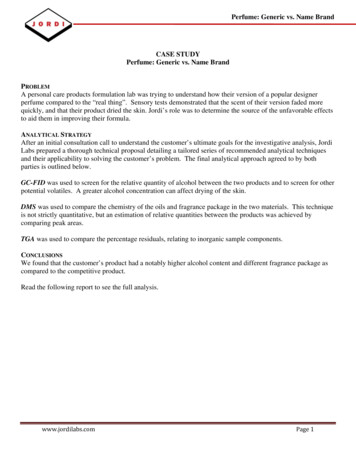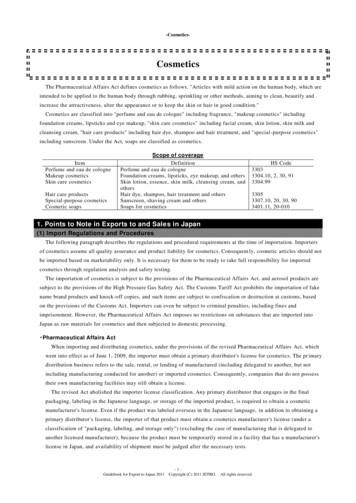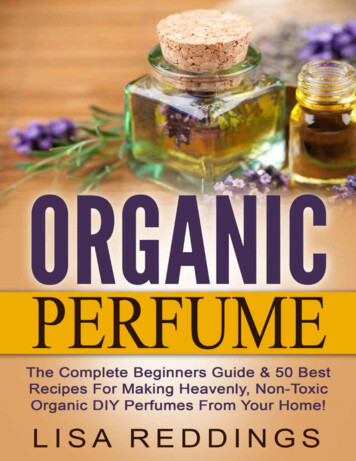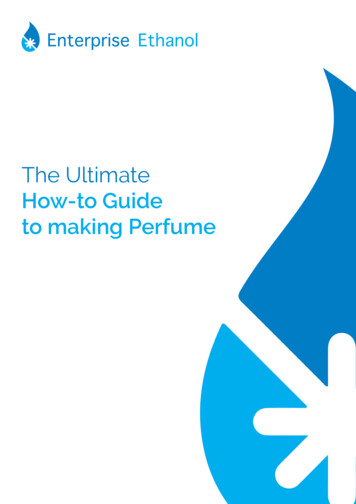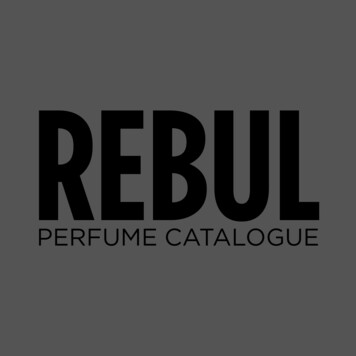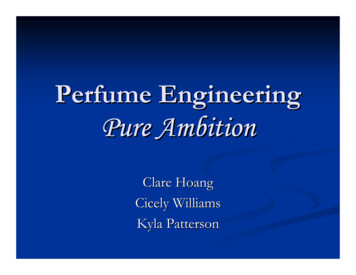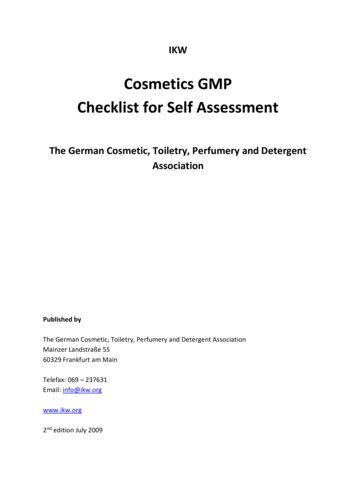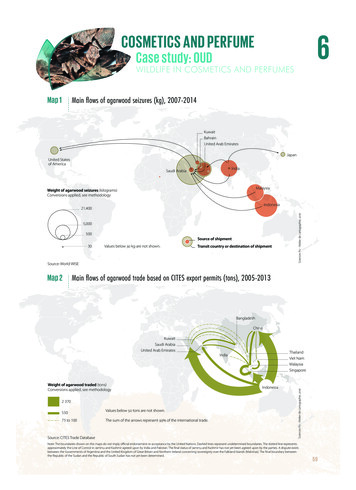
Transcription
6COSMETICS AND PERFUMECase study: OUDWILDLIFE IN COSMETICS AND PERFUMESMain flows of agarwood seizures (kg), 2007-2014Map 1KuwaitBahrainUnited Arab EmiratesJapanUnited Statesof AmericaIndiaSaudi ArabiaMalaysiaWeight of agarwood seizures (kilograms)Conversions applied, see methodology5,000500Source of shipment30Values below kg are not shown.Transit country or destination of shipmentSource: World WISESciences Po - Atelier de cartographie, Indonesia21,400Note: The boundaries shown on this map do not imply official endorsement or acceptance by the United Nations. Dashed lines represent undetermined boundaries. The dotted line representsapproximately the Line of Control in Jammu and Kashmir agreed upon by India and Pakistan. The final status of Jammu and Kashmir has not yet been agreed upon by the parties. A dispute existsbetween the Governments of Argentina and the United Kingdom of Great Britain and Northern Ireland concerning sovereignty over the Falkland Islands (Malvinas). The final boundary betweenthe Republic of the Sudan and the Republic of South Sudan has not yet been determined.Map 2Main flows of agarwood trade based on CITES export permits (tons), 2005-2013BangladeshChinaKuwaitSaudi ArabiaUnited Arab EmiratesWeight of agarwood traded (tons)Conversions applied, see methodology2 37055075 to 100Source: CITES Trade DatabaseValues below tons are not shown.The sum of the arrows represent of the international trade.IndonesiaSciences Po - Atelier de cartographie, ThailandViet NamMalaysiaSingaporeIndiaNote: The boundaries shown on this maps do not imply official endorsement or acceptance by the United Nations. Dashed lines represent undetermined boundaries. The dotted line representsapproximately the Line of Control in Jammu and Kashmir agreed upon by India and Pakistan. The final status of Jammu and Kashmir has not yet been agreed upon by the parties. A dispute existsbetween the Governments of Argentina and the United Kingdom of Great Britain and Northern Ireland concerning sovereignty over the Falkland Islands (Malvinas). The final boundary betweenthe Republic of the Sudan and the Republic of South Sudan has not yet been determined.WLC 2016 BOOK.indb 595913/05/2016 15:10:53
COSMETICS AND PERFUMEWild plants and animals have longformed the basis of cosmetics andperfumes. Exotic animal products likemusk and ambergris have largely beenreplaced with synthetic alternatives,but demand for wild-sourced plantinputs for the cosmetics and perfumeindustries remains strong. For many ofthese plants, cultivation is an alternative, but illegal wild sourcing remainsa risk where this is not cost-effective.The global trade in essential oils, perfumes, cosmetics, and toiletries wasworth just under US 112 billionin 2014.1 That year, Europe aloneimported 89,000 metric tons of essential oils, 40,000 metric tons of plantextracts, and 194,000 metric tons ofraw plant material for the cosmeticstrade, worth around 2.5 billion euros.2It is estimated that over 70% of theEuropean trade volume in medicinaland aromatic plants comes from wildcollection.3Wild plant populations are generallyless well documented than animalpopulations, complicating the determination of sustainable offtake ofplants. Increases in demand can leadto rapid overharvesting and when thespecies in question is slow to recover, asis the case with many tree species, theimpact can be severe. The overharvesting of Aquilaria species in South andSoutheast Asia, due to the exploitationFig. 1of a product sometimes referred to as“oud”, provides a prime example.OudOud, also known as agarwood, jinkoh,or gaharu, does not refer to a particular species of tree. Rather, it is thename given to a highly aromatic, resinimpregnated wood found in a numberof species of the Thymelaeaceae family.The complex fragrance of this unusualresin has been used in perfumery andincense across a wide range of culturesfor millennia. It has also been ascribedmedicinal and cosmetic benefits, usedin both Chinese4 and Ayurvedic therapies. Its role is prominent in religiousobservance, especially in Muslim,Hindu, and Buddhist traditions.5Oud is produced in trees of six genera,primarily the Aquilaria genera, and,to a lesser extent, Gyrinops and Gonystylus (ramin) species. The primaryagarwood producing species indicated in trade, Aquilaria malaccensis,was placed on CITES Appendix II in1995, while the other species werelisted a decade later. The primarythreat to these species is illegal harvesting for the agarwood trade, becausea single kilogram of high qualityoud chips can be worth hundreds ofthousands of dollars.6 It is likely thesingle most value-intensive wildlifecommodity.Rival buyers are engaged in a race toacquire the few remaining wild stocks.Local communities in the traditionalsource areas are generally aware of theIndiaChinaUnited States of AmericaFranceUnited KingdomBrazilGermanyIndonesiaOthers4,000,000US 1000sSimilar to wine, the value of agarwoodis subjectively determined and pricescan vary greatly between ostensiblysimilar products. Agarwood connoisseurs can differentiate between thescent profiles of oud wild-sourced inparticular regions, and the quality ofextracts is greatly dependent on theskill of the manufacturer. As particularregional stocks are harvested to extinction, there is evidence that speculativebuying is taking place.7 The growingdemand for this highly valuable woodhas led to both a looting of the wildmaterial (as evinced in the seizuredata), and the launch of many largescale cultivation operations across theregion (as documented below).Value of global exports of “essential oils, resinoids, and terpenic by-products” by country ofexport (US 1000s), 2010-20145,000,000WORLD WILDLIFE CRIME REPORT 2016Only a very small share of Aquilariatrees actually manifest oud and theresin impregnated wood cannotalways be detected externally, leadingto many trees being felled fruitlessly.The resinous wood is produced asa defensive reaction when the treeis damaged but its incidence is rareand difficult to predict. In the past,source trees were used sustainably bylocal communities, but commercialpressure has led to widespread 1201220132014Source: International Trade Centre Trade Map, using COMTRADE data60WLC 2016 BOOK.indb 6013/05/2016 15:10:55
While Aquilaria species grow well inplantations, production of high quality oud from cultivated stock has beenelusive. Aquilaria species require up toa decade to reach maturity and current harvesting techniques, both wildand in cultivation, involve destroyingthe entire tree. The process of inducing oud production has not been wellunderstood until recently and theindustry has been fraught with secrecyand misinformation. For example, inthe past, it was thought infection witha specific fungus (such as Cytosphaeramangiferae) was necessary for resinproduction but this does not appearto be the case.9As a result, present capacity to produce cultivated oud is unclear, andclaims of high-volume productionshould be scrutinized. There remainsa risk that wild sourced agarwood maybe laundered through firms involvedin cultivation, particularly those thatare vertically integrated with firmsproducing items for sale. The value ofthe wood is so great that the possibleextinction of some Aquilaria speciesin the wild as a result of high demandremains a matter of serious concern.10Table 1Based on CITES trade data, there arethree principal ways that pure oud istraded internationally:- --- Resinous timber and wood chips- --- Distilled oil for perfume- --- Exhausted powder for incenseRaw agarwood, usually in the formof chips, can be an end use product.The highest quality wood is burnedas whole chips for its fragrance,while somewhat lesser quality woodis reserved for oil extraction. Lowergrades of wood may also be carvedinto objects, like sculptures and beads,that retain their aromatic qualities foryears, although it appears that mostbeads in circulation are actually lesserwoods soaked in oud oil.11Oil extraction techniques are considered proprietary and often closelyguarded. Good technique is said todrastically increase both quality andyield with most production today.12Once the oil has been extracted, theremaining wood still retains somearomatic qualities, and is generallyreduced to powder for use in incenseor bakhoor, bricks burned in censersin some Arabic countries. It can alsobe pressed into small statues, often ofreligious significance. For statisticalpurposes, these three product categories are combined into raw agarwoodequivalents in the analysis below,based on conversion rates.136Source of agarwoodCASE STUDY: Oudvalue of agarwood and scout for thesebuyers. As a result of this intensiveprospecting, protected areas containsome of the few remaining specimensin the wild.8Although all the known agarwoodproducing trees are found in broaderSouth and Southeast Asia, there havebeen no recent, global populationassessments for these species. Eventhe number of species within thesix genera has not been scientificallyresolved. Trade data suggest that mostagarwood exports involve Aquilariaspecies, but Aquilaria are seen acrossa very wide area, and not all speciesproduce oud. For example,according to IUCN, Aquilaria malaccensisgrows wild in a number of countriesin the region, including Bangladesh,Bhutan, India, Indonesia, the IslamicRepublic of Iran, Malaysia, Myanmar,the Philippines, Singapore, and Thailand.14Legal tradeThe value of agarwood, and its scarcity in the wild, has been recognizedsince the early 20th Century, so cultivation occurs in a number of rangestates. Based on CITES trade data,however, between 2005 and 2013,only 30% of agarwood exports byvolume were from cultivated sources(Table 1). While several countriesreported cultivated exports (includingBangladesh, Indonesia, Lao PeoplesDemocratic Republic, Myanmar andKnown agarwood populations in selected countriesCOUNTRYKNOWN POPULATIONEXPORTSBangladesh6,000 ha on government plantationsAbout 124 tons of chips from private growers in 2014BhutanAbout 23,000 trees cultivated15NoneChinaAbout 130,000 trees in the wildNegligible in 2012-201516IndiaAbout 10 million trees in plantationNone, just re-exportsIndonesia3.5 million in plantation700 tons in 2013, about 80% low qualityMalaysiaJust under 1 million trees in plantations 200 tons quotaMyanmar34,475 trees in home gardens;680 ha in plantationsNoneThailandViet NamUnknown18,000 ha in plantations;1 million trees in home gardens8 tons of oil, 15 tons of chips in 2013300 tons of wood exported 2009-2014Source: ITTO 1761WLC 2016 BOOK.indb 6113/05/2016 15:10:57
COSMETICS AND PERFUMEFig. 2 CITIES-listed agarwood legally exported by wild or 00720060WildMalaysia7CultivatedSource: CITES Trade DatabaseFig. 3 Share of wild-sourcedagarwood exports bycountry of export (metrictons), aggregated 2005201418Thailand Other277 147MalaysiaSource: World WISEand Malaysia. Between 2005 and2013, Indonesia reported exportingalmost 7,000 tons of wild sourcedagarwood. If each Aquilaria tree yieldsa half a kilogram of agarwood,19 forexample, this could be the equivalentof approximately three million trees.The value of this trade is highly uncertain, as high quality products can costhundreds of times as much as theirlow quality equivalents.Illegal trade2,106Indonesia6,760Source: CITES Trade DatabaseWORLD WILDLIFE CRIME REPORT 2016seizures by country identified as source (metrictons), aggregated2005-2014212,5002005Metric tons of agarwood exportedvated source (metric tons), 2005-2013Fig. 4 Share of total agarwoodViet Nam), more than three-quartersof the cultivated exports during thatperiod were reported by Thailand.Legal wild-sourced exports more thandoubled between 2005 and 2013.The volume in 2013 was 591 tonsof chips, about 218 liters of oil, and875 tons of powder were declaredexported from the wild.The primary legal exporters of wildsourced agarwood today are IndonesiaThe volume of illegal agarwood seizedamounts to approximately a half percent of the volumes in legal trade. Itis likely, however, that a very smallshare of the illegal trade is detected,since the product can assume manyforms, and awareness of this amongenforcement officers is often very low.High quality agarwood is so valuablethat it can be couriered by passengerson commercial air flights, a technique with a low chance of detection.Given questions about the ability ofplantations to produce high qualityagarwood, it also appears likely thatsome wood exported as cultivatedwas, in fact, wild sourced.20Still, even the volumes seized aresignificant in terms of both valueand environmental impact. The twocountries listed as primary sourcesof detected illegal shipments are thesame two countries reporting thegreatest volumes of wild-sourced legalexports: Indonesia and Malaysia. Inaddition India, which is within therange but which may also be servingas a conduit for shipments from Bangladesh, features prominently in illegaldetections. In the Arabian Peninsula,the United Arab Emirates has beendetected as a re-exporter.Destination marketsBased on CITES trade data andseizure data, at least four distinct destination markets can be identified foragarwood:- --- the Arabic market for oud oil,high quality chips, and lesserquality products for bakhoor;- --- the Asian market forexhausted powder, usedfor making joss sticks;- --- the Asian market for small solidwood products, such as prayerbeads and small sculptures;- --- The Asian market for medic-inal agarwood products.The primary importers of legallytraded wild-sourced agarwood todayare China, Singapore, Saudi Arabia,62WLC 2016 BOOK.indb 6213/05/2016 15:10:57
a re-exporter of agarwood products.The Arabic market is also clearly indicated in the legal import data.wild-sourced agarwoodlegally imported by country of import (metric tons), With regard to seizures, the mostaggregated 2005-201422 prominent destination is clearly theUnited ArabEmirates Other1,048 846Arab peninsula, with over 90% of theseizures by weight indicating SaudiArabia or the United Arab Emirates,when the destination was ,377Source: CITES Trade DatabaseFig. 6 Share of agarwoodseizures by country identified as destination(metric tons), aggregated2007-201423Japan0.4United StatesOther1.4 0.1UnitedArabEmirates5.3ArabSaudi Arabia21.5Source: World WISEand the United Arab Emirates. Mostof China’s imports appear to beexhausted powder moving from Indonesia to Taiwan Province of China,used in incense manufacture. Onlya relatively small amount (about twotons per year on average) is importeddirectly to mainland China. Singaporeappears to be both a consumer andInterviews with traders in the fieldsuggest a perilous situation for theAquilaria species. Attempts to cultivate agarwood have produced verymixed results, and connoisseurs willpay outrageous amounts for the mostsought-after wild strains. This hasproduced a kind of gold rush in thewoodlands of Southeast Asia, whereprospectors scour the wild in the hopeof a lucky find, and specialised distillers feel obligated to buy what theycan, rather than allowing the last ofthis precious commodity to fall intoless skilled hands. These suppliers arecompeting for a limited number ofvolume buyers, who may be willinglyblind to the source of their stock.Laundering of wild-gathered product through plantations appears to beoccurring.24World WISE contains data on seizuresof about 35 metric tons of agarwoodbetween 2005 and 2014, which couldbe the result of the illegal harvest ofup to 70,000 trees. Agarwood chipsmade up the largest share of theseseizures by estimated value, althoughlarge volumes of powder and someoil were detected. There are severalreasons to regard this as a seriousunderestimate of the scale of the illegal trade, as clearly not every illicitshipment was seized. World WISEcontains only 230 agarwood seizurerecords, so most of the value comesfrom a small number of large interdictions. As a result, the seizure record isextremely volatile. Given that woodworth thousands of dollars can becarried in a pocket, it is highly likelythat “ant” trafficking takes place acrossborders of Southeast Asia. Some ofthe key countries in the contraband6flow, based on seizures made in othercountries, have never reported anagarwood seizure. It is also possiblethat a share of the legal exports wereillegally sourced – at present, thelegal trade (about 10,000 metric tons2005-2014) is over 300 times the sizeof the detected illegal trade (about 30metric tons in the same period).CASE STUDY: OudFig. 5 Share of CITIES-listedFurthermore, it is likely that agarwood, like other forms of timber, isunder-detected because of the difficulties in distinguishing between woodspecies. To those unfamiliar with it,the chips appear as rather unremarkable, although fragrant, bits of wood.As an oil, it can be bottled like otherperfumes or cosmetics. As a powder,it is essentially saw dust. The highquality wood and oil are value-intensive, and personal couriering oncommercial air flights appears to be anissue. Finally, the current exceptionsto CITES requirements could allowresinous powder to be exported asexhausted powder, and other productsto be packaged for retail sale beforeexport, so evading import regulations.Endnotes1 According to Trade Map statistics: http://www.trademap.org/Country SelProductTS.aspx Netherlands,2 Netherlands, Ministry of Foreign Affairs,Natural Ingredients for Cosmetics inEurope (The Hague, cs-2015.pdf3 Belgium, Belgian Development Agency,“Wild-Collected Botanicals and the EUMarket” (Brussels, 2015), p. 27.4 As “Chen Xiang”5 Angela Barden and others, “Heart of theMatter: Agarwood Use and Trade and CitesImplementation for Aquilaria Malaccensis”(2000), retrieved on 21 September 2015from Traf-072.pdf. Retrieved 21September, 2015.6 ITTO, “Report of the Asian RegionalWorkshop on the Management of Wildand Planted Agarwood Taxa”, (Guwahati,Assam, India, January 2015).63WLC 2016 BOOK.indb 6313/05/2016 15:10:58
WORLD WILDLIFE CRIME REPORT 2016COSMETICS AND PERFUME7 Interviews with agarwood traders contactedin connection with this report, May-October 2015. See online methodological annexfor details.8 According to agarwood traders interviewedfor this report: see online methodologicalannex for details.9 Robert Blanchette and Henry Heuvelingvan Beek. 2005. Cultivated Agarwood. USPatent 6,848,211; Robert Blanchette, JoelJurgens and Henry Heuveling van Beek,“Growing Aquilaria and Production ofAgarwood in Hill Agro-ecosystems”, inIntegrated Land Use Management in theEastern Himalayas, K. Eckman and L.Ralte, eds., (New Delhi, Akansha Publishing House, 2015), pp. 66-82.10 For example, Aquilaria malaccensis isdeemed critically endangered in India andits export is 6/011 Based on interviews with agarwood tradersconducted for this report: see online methodological annex for details.12 Most extraction today involves one of threebroad methods: hydro-distillation; pressured steam distillation; and super critical CO2 extraction.Hydro-distillation is perhaps the oldestand most labor intensive of the threeand involves soaking the wood, boiling itin water and removing the oil from thewater surface. Yields can be as little as0.1%. Pressurized steam is faster but risksscorching the wood and may include woodextractives which corrupt the primaryproducts demanded by the market. Thetwo techniques may be used by the sameproducer to bring out different qualities ofthe wood. The use of carbon dioxide as asolvent is less common but has the potential to produce greater yields. Again, however, the process often extracts waxes andother tree derivatives which can adulteratethe final product. Many other techniquesare currently being reviewed in the questfor higher yields and quality. These includesolid liquid extraction, microwave assistedextraction, spinning band distillation,ultrasonic assisted steam distillation andultrasonic assisted hydro-distillation.13 Although the resin content of agarwoodvaries, as does extraction efficiency, in thefigures below oud oil is converted at theratio of 143 kg of agarwood to one liter ofoil. “Powder” can connote either exhaustedpowder or resinous powder; because ofthis ambiguity, these figures are not converted. All shipments of agarwood chipsand timber remain as reported. See onlinemethodological annex discussion of conversion rates for details.14 See IUCN Red List entry for Aquilariamalaccensis: http://www.iucnredlist.org/details/32056/015 2,341 trees in the wild, 2,487 trees in plantations, 827 in research, 15,000 in nurseries and 2,443 in home gardens.16 Based on CITES Trade Data.17 ITTO 2015, op cit. The countries listedwere the countries providing data at thismeeting.18 Oil exports converted to agarwood equivalents at a ratio of 1:143.6. Powder exportsare assumed to be resin-infused and soare deemed equivalent to chip or timber192021222324exports. See the official conversion figuresused by the UAE as cited in Marina Antonopoulou, and others, “The Trade and Useof Agarwood (Oudh) in the United ArabEmirates,” (Cambridge, TRAFFIC, 2010)Based on interviews with agarwood tradersconducted for this report: see online methodological annex for details.UNODC field research, for more detailssee online methodological annex.Antonopoulou, and others, 2010, op cit.Ibid.Ibid.Based on interviews with agarwood tradersconducted for this report: see online methodological annex for details.64WLC 2016 BOOK.indb 6413/05/2016 15:10:58
inputs for the cosmetics and perfume industries remains strong. For many of these plants, cultivation is an alterna - tive, but illegal wild sourcing remains a risk where this is not cost-effective. The global trade in essential oils, per-fumes, cosmetics, and toiletries was worth ju

